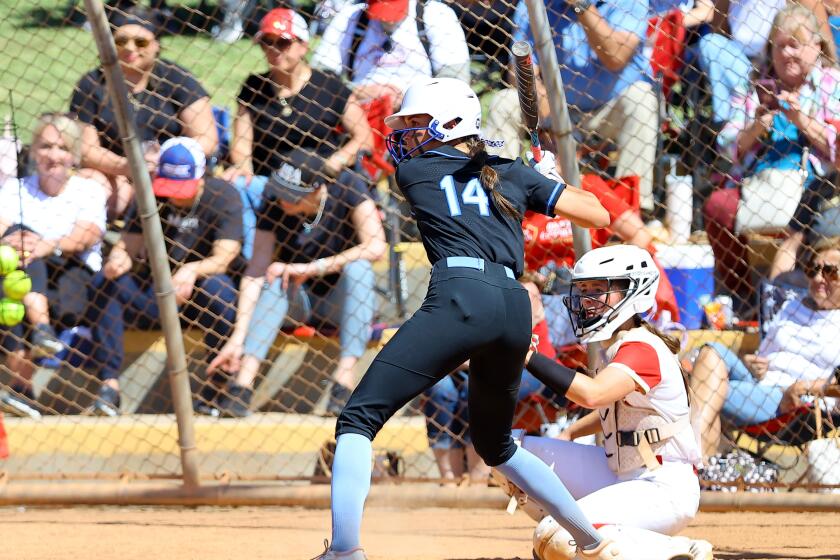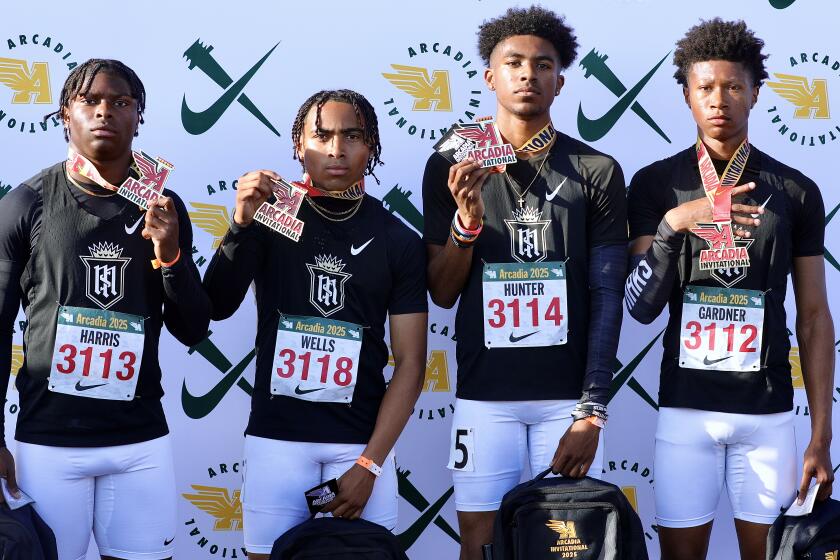Taking the Wraps Off Stupidity
- Share via
I guess I have to address the Lisa Olson-locker room sexual harassment issue. Everyone else has.
The party line, we journalists’ stance, is: How dare these scumbag athletes harass this sportswriter in the dressing room just because she’s a female? OK, I’ll buy that. I’m a journalist. I’m on her side.
And sexual harassment of any kind is unconscionable whether it takes place at the office water cooler or Central Park. It’s ugly, dangerous. It’s criminal. Do it in Central Park and you go to jail. Do it in the New England Patriots’ locker room and the owner profanely defends you.
OK, to sum up, here is my view:
1) Lisa Olson, as an accredited journalist, had every right to be in the football locker room. As a woman and a citizen, she had every right to be free from sexual harassment by a gang of allegedly naked bullies. Anywhere.
2) Harassment of journalists by athletes in locker rooms is not new and predates women in the locker room by about a century. It went on before women went in locker rooms. It’ll go on after.
Item: Sam Wyche, Cincinnati coach, was fined $30,000 for denying a female reporter access to his locker room. Jim McMahon never even got a reprimand from the league for blowing his nose in the direction of a reporter in another locker room in San Diego.
Like most sportswriters, I have been abused, vilified, threatened and ignored in locker rooms, even thrown out of one once by a ballplayer who didn’t like something I wrote. It’s one of the hazards of the business. If you put out oil-well fires, you expect to get burned. You deal with athletes who have just lost a ballgame--or a World Series--you expect to get abused.
When the harassment takes on sexual overtones, it becomes ugly, although there were jeers along those lines even in the all-male days.
I am old-fashioned enough to have been shocked when the first women appeared in locker rooms. And, frankly, if I were an athlete, I would not want a chorus of strange women watching me take a shower. I do not look good in a shower. I don’t work out often enough and I prefer to meet women in a tuxedo if possible.
However, having said that, I must admit that I have never seen a female reporter behave in anything but a highly professional manner in a locker room. I have never heard one tell a leering, off-color joke about it afterward. I have heard plenty from male reporters.
The interesting point about equal access is that most of the time male reporters are not permitted to enter women’s locker rooms, so female reporters have to be barred (from women’s locker rooms), too. In other words, if men can’t go in, neither can women.
So, tennis and golf and volleyball and track dressing rooms are generally off-limits to all reporters, and the cognizant associations require their athletes to consent to a news conference immediately after the competition in a neutral site where dress is not optional.
It’s come to this anyway in major athletic events. A Super Bowl. With upward of 1,500 sportswriters on hand, the league has had to resort to the postgame tactic of bringing the star performers to a mass interview staging area where they stand on platforms to field questions from the media. The World Series has had to do that, too, although in both cases the locker rooms are also open.
The rub is, in this day of super-saturation of an event by television, print reporters have to come up with another dimension to the story, other than who-won-and-how. To do this, they need the one-on-one, locker-side interview.
It wasn’t always this way. Back in the old, pre-TV days, plenty of beat reporters never bothered with the locker room. Jim Brosnan, who pitched for several seasons in the old Coast League, was at my house and I idly mentioned a writer who had covered the team for years. “You know so-and-so?” I asked Brosnan. He shook his head. “But you must have seen him in the locker room in all those years?” “Never,” said Brosnan. “He never came in.”
You can’t do that today.
The Constitution guarantees equal rights for all. There are laws to protect women from sexual harassment. These are facts that should have been known by the owner of the New England Patriots.
To me, the reactions of the owner are as reprehensible as those of his players. Victor Kiam, as an owner, should know how important the media is to his sport. You don’t expect rookie players to realize that they’re getting $2 million a year to bounce a ball upcourt or fall on a fumble because of the millions of words of free publicity given to their sport. Owners should know it. Owners should also know the Constitution. Football players sleep through classes. Guys who own electric-razor companies presumably don’t. Kiam’s insensitive remarks smacked of those guys who cheered a rape in a Massachusetts bar.
Equal access has been court-ordered by a federal judge (and a woman at that), Victor, and you and your team better get used to it.
The social scientists tell us we are tending toward a unisex society anyway. Well, the hell with that. On that, I’m on the side of the French, Vive la difference!
But the relationship between athlete and journalist in a locker room is, too often, an adversarial one. There are mature adult athletes who recognize the value to their profession of publicity. Then there are those who refuse to talk to the media at all. Their privilege.
Then there are the cretins who profanely and obscenely knock you out of their space. It’s probably good news for everybody that they have been called to account, and Lisa Olson may have taken a big step toward promoting civility to all in the locker room. If you still have confidence in the system, that is.
As Lincoln said, “To give any man (or woman) freedom is to give it to yourself. To deny any man freedom is to deny it for yourself.”
More to Read
Go beyond the scoreboard
Get the latest on L.A.'s teams in the daily Sports Report newsletter.
You may occasionally receive promotional content from the Los Angeles Times.










